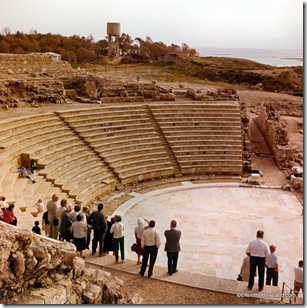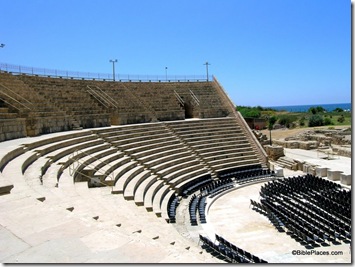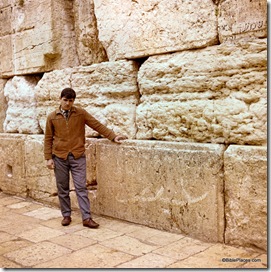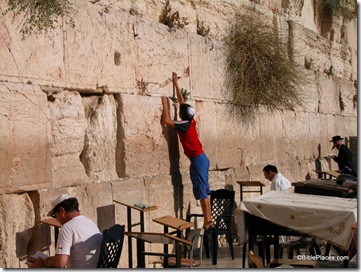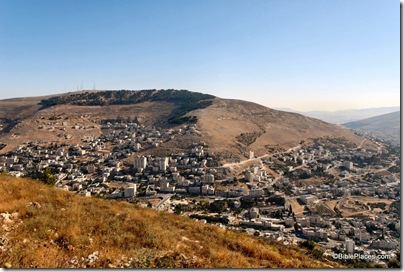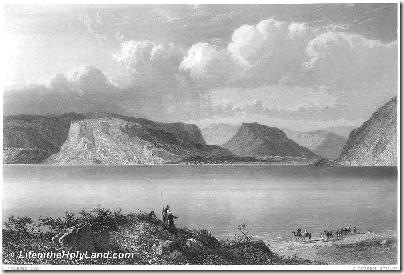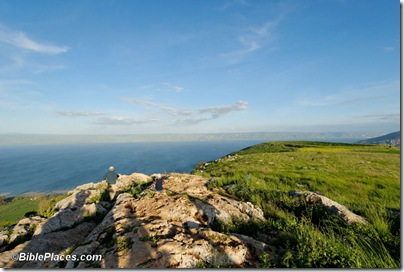Visitors to ancient sites in Israel often wonder how much has been restored and how much is original. Sometimes there is a snaking black line that the restorers have placed just to answer this question. But oftentimes there is no such indicator, and the tourist may imagine that what he is seeing has stood intact since the biblical period. One site that I was long unaware of the degree of reconstruction was the theater of Caesarea. Constructed by Herod the Great, this theater was the location of the incident in Acts 12:19-24 where Herod’s grandson, Agrippa I, was struck down (see Josephus, Antiquities XIX.8.2). But much transpired between then and now, and the photo below gives an idea of the poor preservation of the upper seating area of the theater.
After the Israelis captured the Old City in June 1967, significant attention was given to the development of the Western Wall area. During creation of the large prayer plaza that exists today, the ground level was lowered by about six feet (2 m). Recently when working with the photographs of David Bivin, I came across this photo.
With the distinctive crack in the rock visible behind the young man’s legs, I set about finding a recent photo of the same rock. The photo below shows the crack behind the man’s right hand. In 1964, ground level was located at the position of his left hand.
Note that he is standing on a chair. This is the best illustration I know of that shows the change in plaza level after 1967.
You can see a photo taken by Amihai Mazar that shows a bulldozer clearing the area in the excellent book by Leen Ritmeyer, The Quest: Revealing the Temple Mount in Jerusalem, page 22.
Some other “Then and Now” photos from the Views That Have Vanished collection are posted here.
- Tagged Jerusalem, Temple Mount, Then and Now
In 1879, J. W. McGarvey made a tour of the Holy Land. His visit to the area of Nablus (biblical Shechem) is particularly interesting because of his acoustical test. Today tourists are not able to visit this area, and if they were, the urbanization of the area has made a similar experience impossible today. This section is from Lands of the Bible, originally published in 1880, pages 506-8 (emphasis added). A limited preview is available at Google Books (some copies for sale here). Thanks to Paul Mitchell for discovering this nugget and sending it on.
“On reaching Shechem we called on Brother El Karey, the only Baptist missionary in Palestine. I had a letter of introduction to him, given me by a Baptist preacher from London whom I met at Naples.
He received us very cordially, explained to us his missionary labors, and, being a native of the place, though educated in England, he was full of the local information for which we were in search. We especially wanted to learn the best way to reach Aenon, the locality of which was definitely fixed by Lieutenant Conder, but which our dragoman had never visited. He gave us the desired information, and the next morning, leaving our tents pitched at Shechem, we made an excursion to that interesting spot.
Our route took us back through the valley, and we resolved that while passing between the two mountains of Ebal and Gerizim, in the still morning air, we would try the experiment of reading the blessings and curses. It will be remembered by the reader that, in compliance with directions given before the death of Moses, Joshua assembled all the people on these two mountains, stationing six tribes on one, and six opposite to them on the other, and he stood between and read to them all the blessings and curses of the law (See Deut 27-28, Josh 8:30-35). It has been urged by some skeptics that it was impossible for Joshua to read so as to be heard by the whole multitude of Israel. It is a sufficient answer to this to show that while Joshua read, the Levites were directed to repeat the words “with a loud voice” (Deut 27:14), and that it was an easy matter to station them at such points that their repetitions, like those of officers along the line of a marching army, could carry the words to the utmost limits of the multitude. But it is interesting to know that the spot chosen by God for this reading is a vast natural amphitheatre, in which the human voice can be heard to a surprising distance. About half-way between Shechem and the mouth of the valley in which it stands there is a deep, semicircular recess in the face of Mount Ebal, and a corresponding one precisely opposite to it in Mount Gerizim. No man with his eyes open can ride along the valley without being struck with this singular formation. As soon as I saw it I recognized it as the place of Joshua’s reading. It has been asserted repeatedly by travelers that, although two men stationed on the opposite slopes of these two mountains are a mile apart, they can read so as to be heard by each other. We preferred to try the experiment in stricter accordance with Joshua’s example; so I took a position, Bible in hand, in the middle of the valley, while Brother Taylor and Frank, to represent six tribes, climbed halfway up the slope of Mount Gerizim; and Brother Earl, to represent the other six tribes, took a similar position on Mount Ebal. I read, and they were to pronounce the amen after each curse or blessing. Brother Taylor heard me distinctly, and I could hear his response. But Brother Earl, though he could hear my voice, could not distinguish the words. This was owing to the fact that some terrace-walls on the side of the mountain prevented him from ascending high enough, and the trees between me and him interrupted the passage of the sound. The experiment makes it perfectly obvious that if Joshua had a strong voice,–which I have not,–he could have been heard by his audience without the assistance of the Levites. As to the space included in the two amphitheatres, I think it ample to accommodate the six hundred thousand men with their families, though of this I cannot be certain. If more space was required, the aid of the Levites was indispensable.”
UPDATE: Biblical Studies and Technological Tools has found and posted better images of the natural amphitheater, using Google Earth, HolyLand 3D and Microsoft Virtual Earth.
- Tagged Samaria, Then and Now
A few years ago I posted a photo comparison of one of the best rolling stone tombs in Israel – before vandals destroyed it and after. For convenience, here are those pictures of the Khirbet Midras tomb again.
1990:

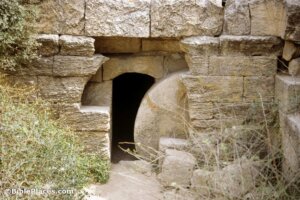
2004:
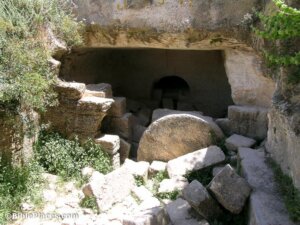
A friend visited recently and passed on a few photos. It looks like the tomb has been partially restored. You might want to stop by next time you’re in the area. Khirbet Midras is east of the road going from Azekah to Bet Guvrin.
- Tagged Then and Now
My earliest memory of a large lake is of Lake Tahoe in northern California, but the body of water I’ve been to the most is the Sea of Galilee. Mark Twain compared the two on his visit in the 1860s:
The celebrated Sea of Galilee is not so large a sea as Lake Tahoe by a good deal—it is just about two-thirds as large. And when we come to speak of beauty this sea is no more to be compared to Tahoe than a meridian of longitude is to a rainbow. The dim waters of this pool cannot suggest the limpid brilliancy of Tahoe; these low, shaven, yellow hillocks of rocks and sand, so devoid of perspective, cannot suggest the grand peaks that compass Tahoe like a wall, and whose ribbed and chasmed fronts are clad with stately pines that seem to grow small and smaller as they climb, till one might fancy them reduced to weeds and shrubs far upward, where they join the everlasting snows. Silence and solitude brood over Tahoe; and silence and solitude brood also over this lake of Gennesaret. But the solitude of the one is as cheerful and fascinating as the solitude of the other is dismal and repellent” (Mark Twain, Innocents Abroad, pp. 375-76).
- Tagged Then and Now
The BiblePlaces Blog provides updates and analysis of the latest in biblical archaeology, history, and geography. Unless otherwise noted, the posts are written by Todd Bolen, PhD, Professor of Biblical Studies at The Master’s University.
As an Amazon Associate we earn from qualifying purchases. In any case, we will provide honest advice.
